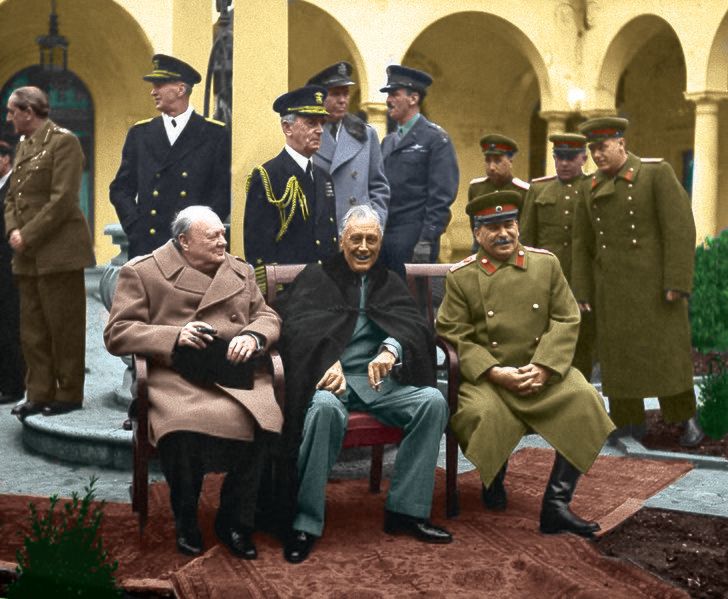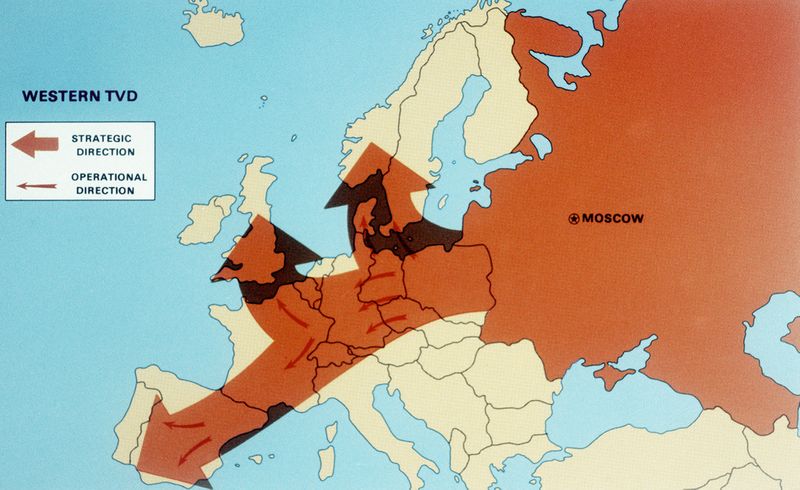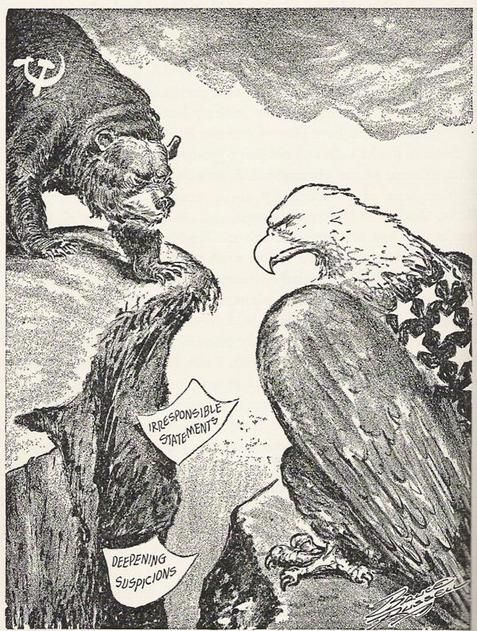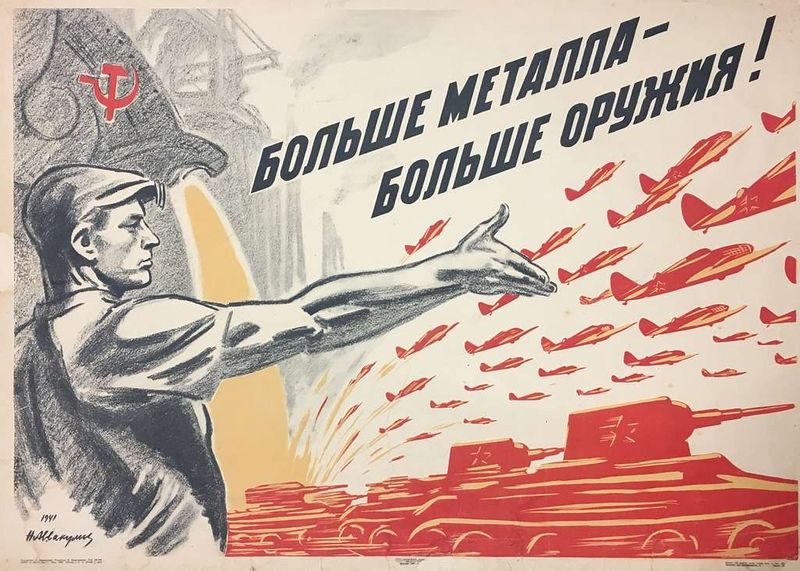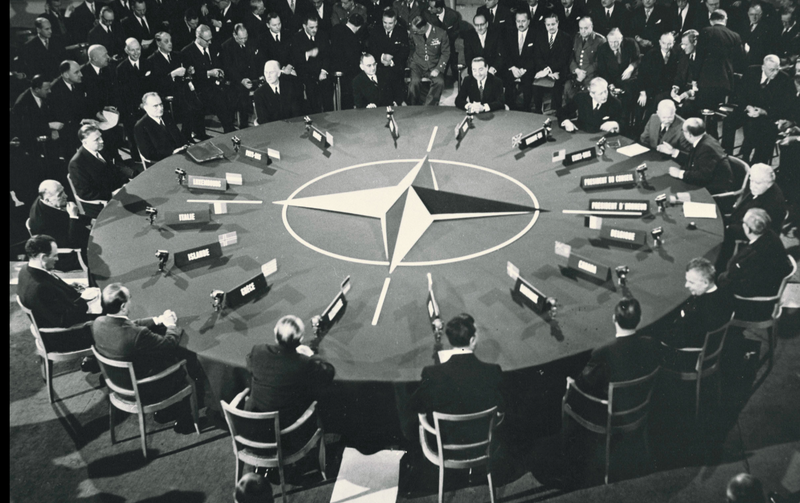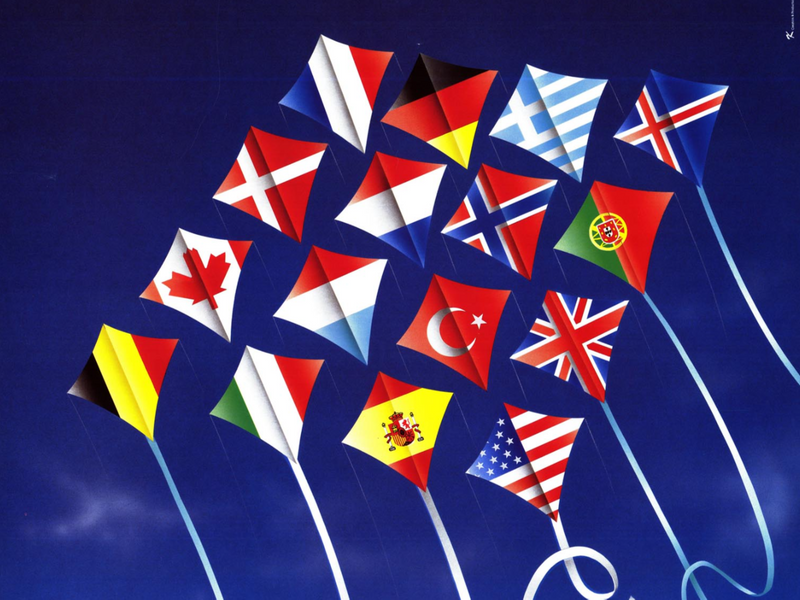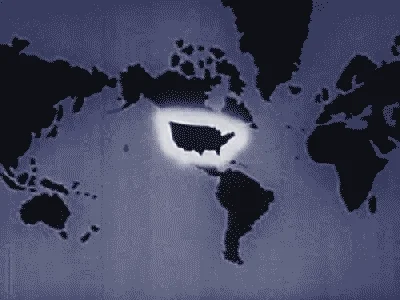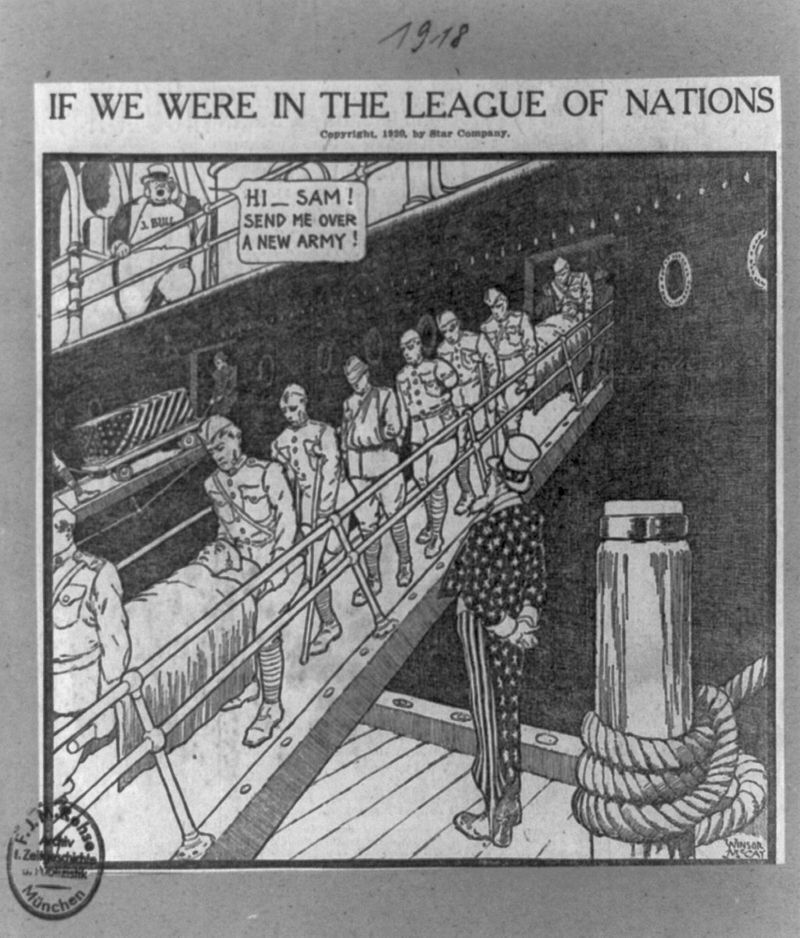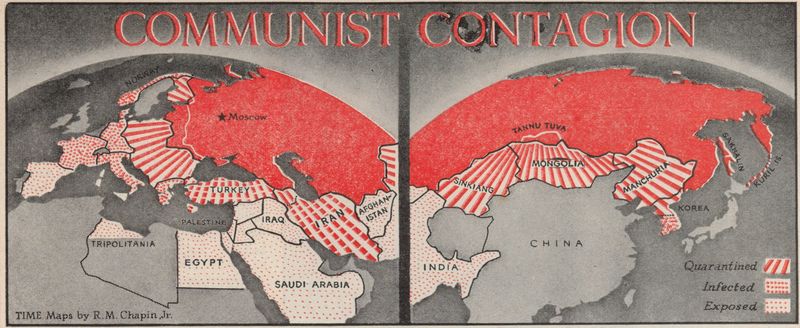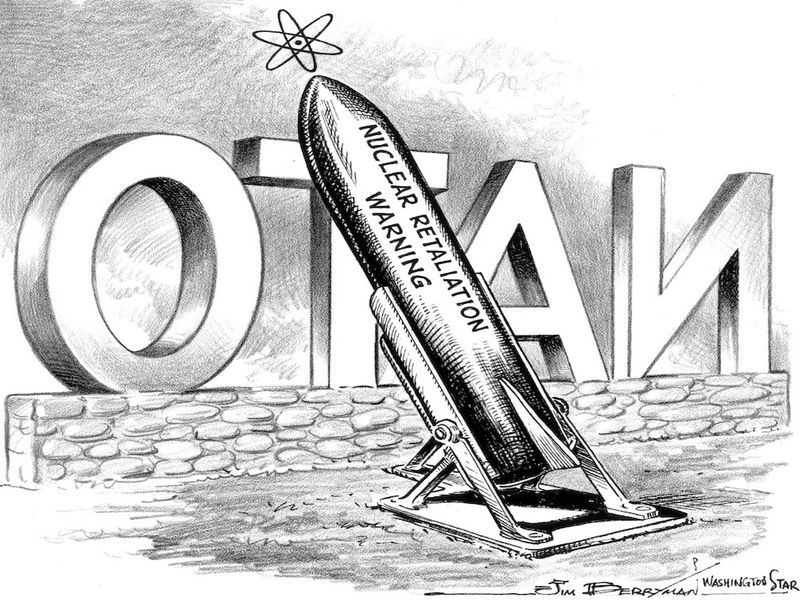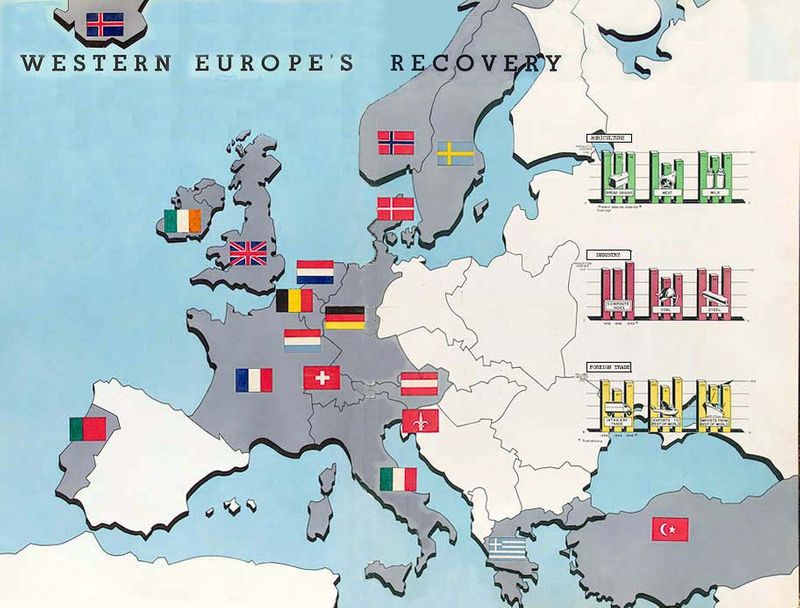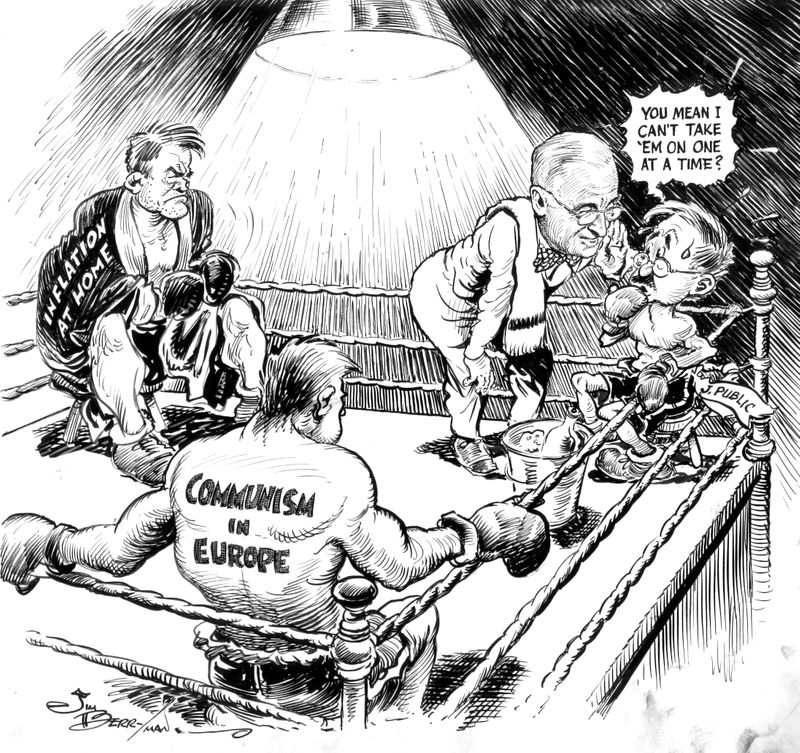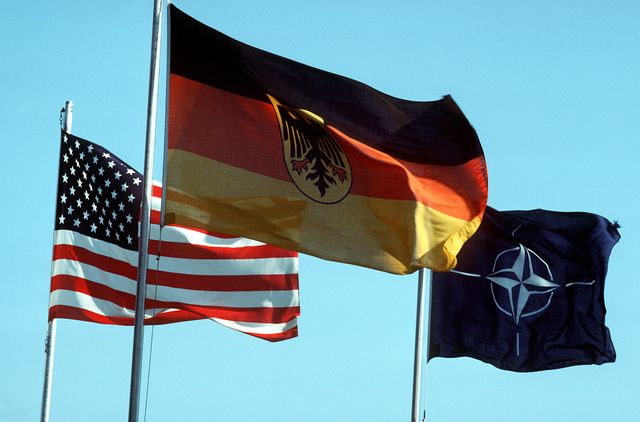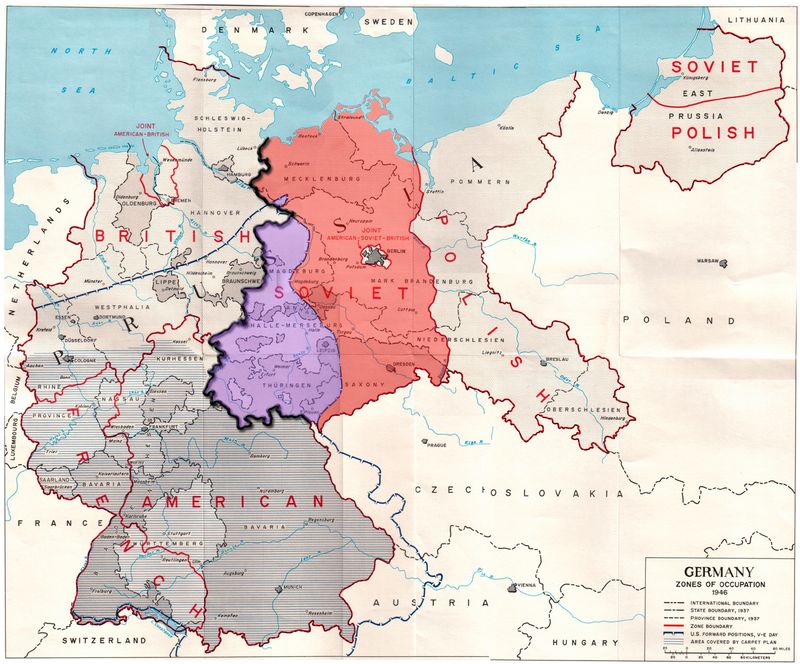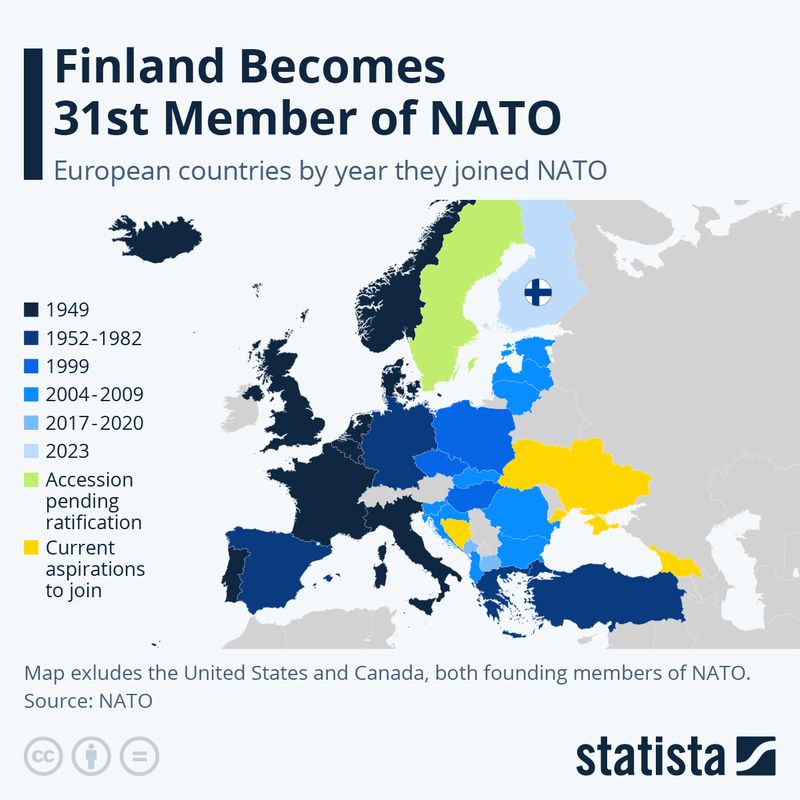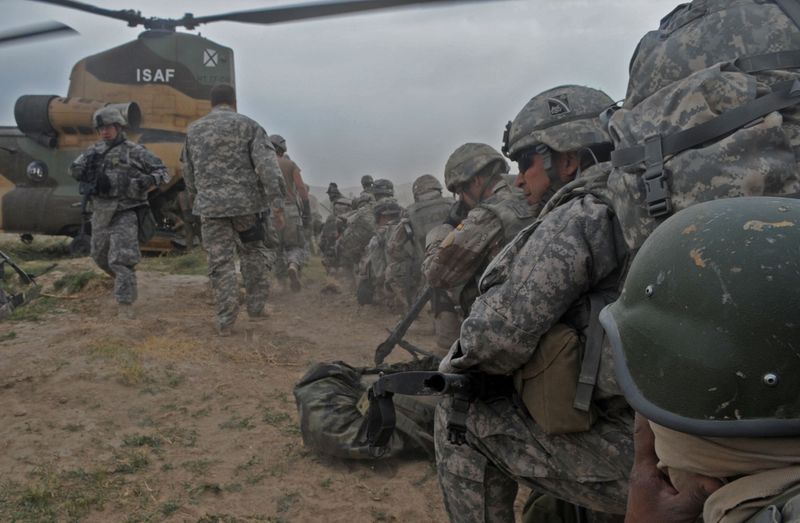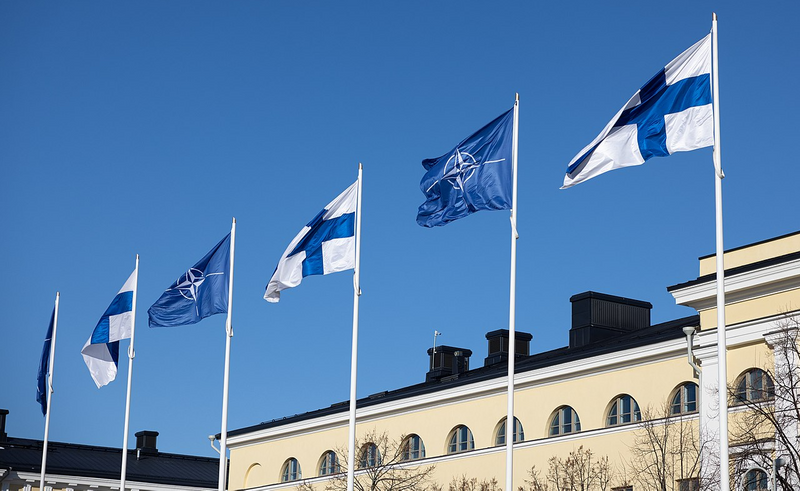
This logo isn't an ad or affiliate link. It's an organization that shares in our mission, and empowered the authors to share their insights in Byte form.
Rumie vets Bytes for compliance with our
Standards.
The organization is responsible for the completeness and reliability of the content.
Learn more
about how Rumie works with partners.
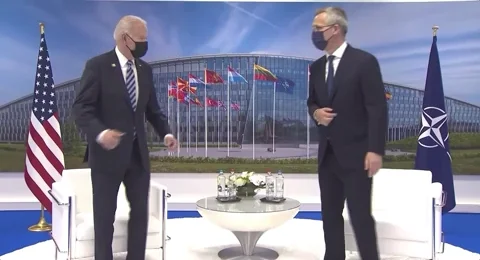
The North Atlantic Treaty Organization (NATO) is one of history's most successful alliances.
In the field of global politics, there are many different definitions of an alliance, but this is a good way to think about them:
When one or more countries want to achieve a common aim, or feel threatened by a common adversary, they'll come together to form a pact that makes themselves stronger than if they were acting alone.
 Alliances can be informal. Many countries have strategic partnerships that aren't necessarily alliances. In these relationships, countries may exchange weapons or provide one another with other forms of military assistance.
Alliances can be informal. Many countries have strategic partnerships that aren't necessarily alliances. In these relationships, countries may exchange weapons or provide one another with other forms of military assistance.
 Alliances can be formal, as in the case of NATO. The North Atlantic Treaty specifies how members of this alliance are bound together.
Alliances can be formal, as in the case of NATO. The North Atlantic Treaty specifies how members of this alliance are bound together.
 Alliances don't have to agree on much — and allies don't even have to like one another. They often form out of necessity.
Alliances don't have to agree on much — and allies don't even have to like one another. They often form out of necessity.
When the United States and the United Kingdom formed a coalition with the totalitarian Soviet Union — a country they had long eyed with suspicion — to defeat Nazi Germany, British Prime Minister Winston Churchill said this, an example of the old maxim that the "enemy of my enemy is my friend":
If Hitler invaded hell, I would make at least a favorable reference to the Devil in the House of Commons.
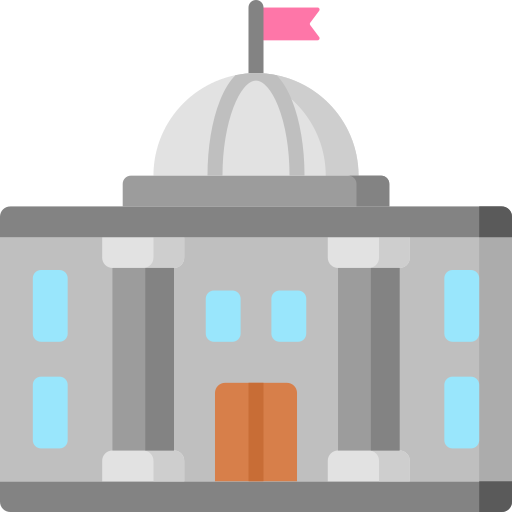 Nor do they need to share a similar political system. Take South Korea or Taiwan in the 1950s when they became American allies — at that time, neither could be mistaken for a pillar of democracy. But they shared with the United States common adversaries: China, North Korea, and the Soviet Union.
Nor do they need to share a similar political system. Take South Korea or Taiwan in the 1950s when they became American allies — at that time, neither could be mistaken for a pillar of democracy. But they shared with the United States common adversaries: China, North Korea, and the Soviet Union.
 Alliances often disband when a common adversary is defeated. At the end of World War II, the Soviet Union turned from America's friend to its foe.
Alliances often disband when a common adversary is defeated. At the end of World War II, the Soviet Union turned from America's friend to its foe.
These two powers, which had teamed up to defeat Germany, no longer felt threatened by Germany but now felt threatened primarily by each other.
 But NATO chose to stay together after the Cold War. It even expanded.
But NATO chose to stay together after the Cold War. It even expanded.
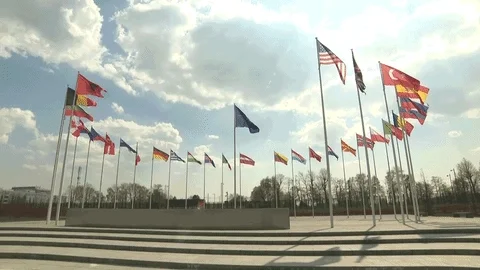 This choice raises many open questions:
This choice raises many open questions:
Why did NATO choose to stick together?
What's NATO's newfound purpose?
What role should the United States and Europe play in the Alliance?
Was it the right choice?
These are questions that foreign policy experts debate today, and there are no clear answers. What do you think?
Keeping the Soviets Out
During the Cold War, NATO's purpose is best captured in words often attributed to NATO's first Secretary General Lord Ismay:
...to keep the Soviet Union out, the Americans in, and the Germans down.
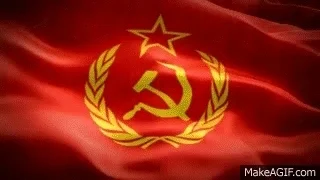 Early Cold War
Early Cold War
Anxieties ran high in Europe and around the world after WWII. The perceived threat posed by the Soviet Union drove Western Europe and North America to form NATO in 1949.
Historians argue over the exact date the Cold War began, but several factors contributed to post-war tensions.
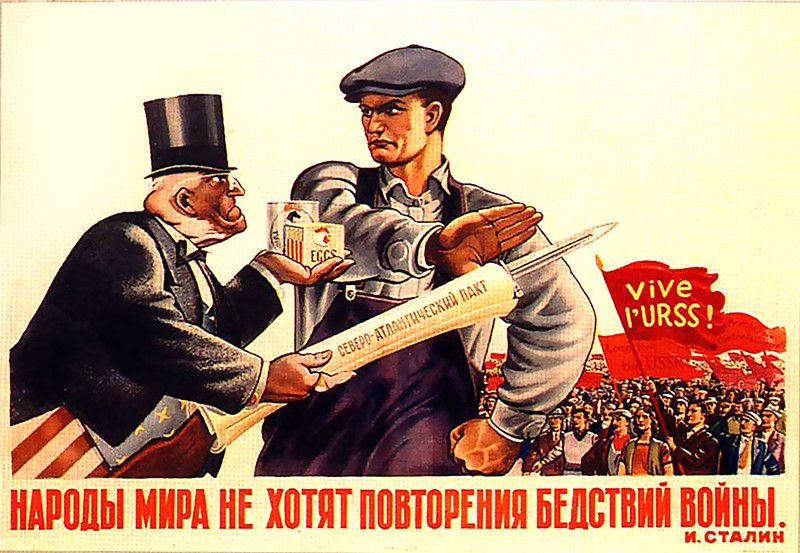 "People of the world do not want a repeat of the disasters of the past."
"People of the world do not want a repeat of the disasters of the past."
Ideological Conflict
The Cold War was a competition defined by power and ideology. There were two sides to this battle: communism and liberalism.
While the Soviet Union espoused communism, the United States and Western Europe promoted liberal values.
Though there are many nuances and a range of beliefs associated with these ideologies, they can be simply defined as:
 Liberalism
Liberalism
Politically, it's a belief that society should be organized to emphasize the rights of the individual and equality before the law. States should be decentralized, and citizens should be represented in their government.
Economically, liberalism emphasizes private property, equal opportunity, and free markets.
 Communism
Communism
Like liberalism, communism is a political and economic ideology. Rather than individual rights, it emphasizes group rights.
Communism envisions a classless society in which private property is curtailed or eliminated. In practice, it has often meant highly centralized governments.
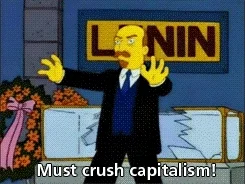
The most fervent liberals and communists believed their chosen ideology could and should be adopted worldwide. In their view, there was little room for competing ideologies to exist side-by-side.
This worsened relations as adherents accused one another of malign intentions.
However, while many in politics and the media played up the ideological component of the Cold War, it's worth asking:
Would a militarily strong USSR have been of equal concern to the United States and Western Europe, regardless of its ideology?
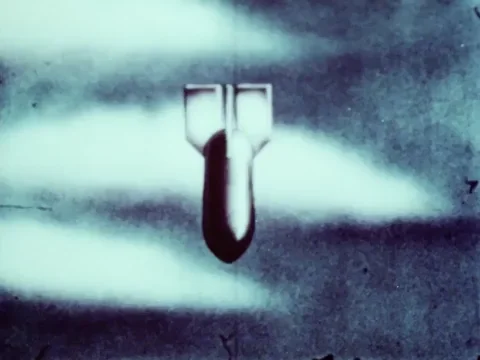 Broken Promises
Broken Promises
Soviet behavior at the end of WWII proved to America and Western Europe that the Soviet Union was an aggressive power.
During the war, the United States liberated Europe from Germany in the West, and the Soviet Union liberated Europe in the East.
However, it appeared Eastern Europe had traded one conqueror for another.
Moscow promised free elections in Poland and the Czech Republic, among other countries.
But free elections never came.
Communist puppet governments were installed in sham elections, and democratically elected governments were ousted in Soviet-backed coups.
It was clear to the West that the Soviet Union couldn't be trusted.
In the words of Winston Churchill, an "Iron Curtain" had descended across Europe, dividing the continent into two spheres of influence.
Soviet Power
The Soviet Union's influence in Europe was backed by its military might. Despite having borne the brunt of WWII's devastation, its forces outmatched those of Western Europe.
Belgium, France, Luxembourg, the Netherlands, and the United Kingdom signed the Brussels Treaty to form an alliance to help compensate for this disparity. They recognized, however, that their strength was limited without the United States.
The Brussels Pact's weakness was fully displayed when it was unable to prevent the Soviet Union from blockading West Germany in what is known as the Berlin Blockade.
In 1948, the Soviet Union attempted to isolate West Berlin to drive out Western influence from East Germany. Moscow cut off access to roads and railroads.
Though Western Europe and the United States successfully delivered food and other aid to the people of West Berlin in the Berlin Airlift, it was evident that Western Europe needed America's power to boost its defenses.
The Atlantic Alliance takes shape.
In April 1949, the United States, Canada, and 10 Western European countries signed the Washington Treaty, also known as the North Atlantic Treaty.
NATO was born.
These countries — and the four others which would join by the end of the Cold War — pledged to uphold the commitment enshrined in Article V of the Treaty: that an attack on one was to be treated as an attack on all.
Keeping the Americans in
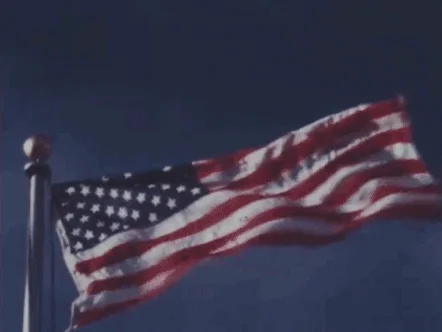
NATO's principal objective during the Cold War was to deter Soviet expansion into Western Europe. And if that failed, defend Europe.
NATO also served another purpose: to keep its European members united, with America's security umbrella as the glue. Without it, peace with Moscow might have seemed a better alternative to some Western Europe countries than standing alone.
America, however, had historically been reluctant to commit itself beyond its own side of the Atlantic.
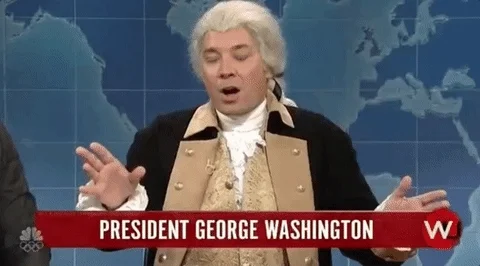
America's Role in the World
The great rule of conduct for us in regard to foreign nations is, in extending our commercial relations, to have with them as little political connection as possible...it is our true policy to steer clear of permanent alliances with any portion of the foreign world.
— George Washington, Farwell Address, September 17, 1776
For much of its history, the United States was wary of permanent alliances. When America was a young country, getting dragged into costly conflicts could have been self-destructive.
America was also able to avoid Europe'sOld World brand of great power politics. After all, America had thousands of miles of ocean between it and Europe.
But this isn't to say that the United States wasn't involved in the world diplomatically and militarily. America...
Conquered territory through wars with Mexico and Native Americans
Engaged in trade
Defended its commercial interests
Asserted authority over Latin America with the Monroe Doctrine
Began to build an overseas empire at the turn of the 19th century
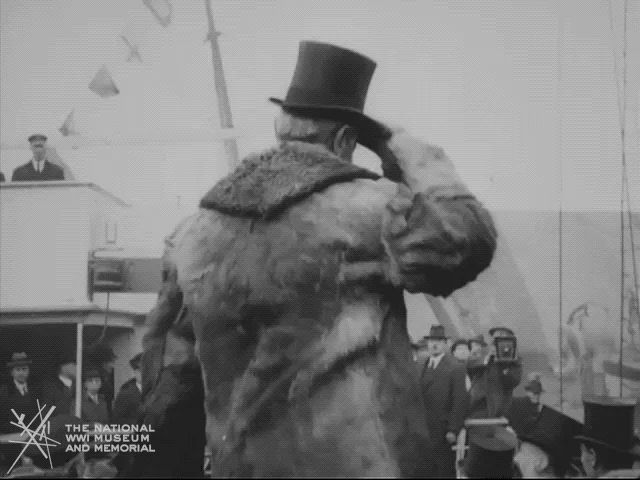
America Goes to Europe
America was neutral at the onset of World War I, but was soon drawn into the conflict. After the war, President Woodrow Wilson unsuccessfully pushed for the United States to join the League of Nations.
Wilson's bid, however, was defeated in the US Senate. Many senators feared the League could entangle America in future European wars.
Then World War II broke out.
Germany's invasion of France shocked Washington. Many policymakers soon realized America could no longer take its security for granted.
It was the age of long-range bombers and aircraft carriers. If Germany conquered Europe, American security and prosperity would be at risk.
Japan attacked Pearl Harbor, and Hitler declared war on the United States in 1941.
America was at war again and would return to Europe — where it would stay.

Containment
For many in Washington, the Soviet Union was the latest country intent on European domination. America was in a bind.
It appeared dangerous to sit around and do nothing while the Soviet Union swallowed Europe. But liberating Eastern Europe and rolling back communism would be too costly and likely unsuccessful.
America took a middle course: it would block further Soviet expansion and wait until Moscow moderated its behavior.
This strategy was called containment, and NATO became Washington's instrument for carrying it through. But for containment's intellectual architect, US diplomat George Kennan, NATO was too blunt an instrument.
Kennan worried that an overly militarized approach to containment could be self-defeating. It might economically and militarily overstretch the United States.
It also risked unnecessarily antagonizing Moscow. Though the United States and its partners viewed NATO as a defensive alliance, the Soviet Union might perceive it as a threat.
This could deepen distrust and raise suspicions in Moscow of Washington's intentions, limiting the room for diplomacy.
Practicing Containment
The United States stayed committed to containment and NATO throughout the Cold War.
American presidents had different approaches. Some were more committed to Europe than others.
US President Dwight Eisenhower, for instance, had wanted to wean Europe off of American support, even if that might have caused Western European countries to acquire nuclear weapons.
There's too much to discuss in one Byte, but knowing how containment evolved in the early Cold War is essential.
 Political and Economic Containment
Political and Economic Containment
Kennan imagined containment as a predominately political and economic strategy prioritizing foreign assistance.
While the military wasn't wholly cast aside in Kennan's formulation of containment — he argued that America needed to defend a few vital geopolitical centers, like Germany and Japan — Kennan didn't view all communist advances everywhere around the world to be an existential threat to the United States.
America, for its part, initially took a balanced, more limited approach to managing the post-war situation in Europe.
The Truman Doctrine and the Marshall Plan are the policies considered the most aligned with Kennan's vision of containment.
Truman Doctrine
In the early Cold War, two big crises erupted:
💥 Moscow sought to control the Turkish Straits — a vital waterway for military and trade.
💥 Moscow backed the Greek Communists in Greece's bloody civil war.
US President Harry Truman addressed Congress and announced financial aid to Turkey and Greece.
Truman also declared that American assistance was to be available to "support free peoples who are resisting attempted subjugation by armed minorities or by outside pressures."
It's worth noting that while Kennan supported US aid to Turkey and Greece, he criticized how Truman marketed it to the American public, which he thought was overly focused on communism.
Marshall Plan
Communism was on the verge of attaining a foothold elsewhere in Europe. Devastated by WWII, Western European economies were weak, and food was in short supply.
The conditions in France and West Germany were particularly concerning: Communist parties grew in influence.
Not only did the Soviet Union carry much prestige for its role in WWII, but communism appeared to be a solution for the ills plaguing Europe.
America responded with a massive aid program, which bore the name of Secretary of State George Marshall.
👉 Listen to this episode of Eurasia Group Foundations' None Of The Above podcast to learn more about George Marshall's legacy.
Some Americans at the time objected to sending large sums of money overseas, but today the Marshall Plan is generally agreed to have been an enormous success. It demonstrated the strength of liberalism's ability to meet people's needs.
Not only was the plan a humanitarian triumph, but it also helped keep Western Europe out of the Soviet Union's orbit and in America's.
 Military Containment
Military Containment
Economic support was helpful. But the militaries of Western Europe were still weak. What good would this aid be if Europe didn't have security?
The United States had the potential to field a powerful military. But it would have to be redeployed.
NATO had formed in the spring of 1949, but America's presence was still not as strong as it would become. Washington had initially cut its defense budget and demobilized its troops following WWII.
Many in Congress and within the Truman administration opposed greater military spending. Some feared that America would become a cash-strapped, regimented state if it kept a large standing in Europe.
But a string of events changed the calculus.
💥 China fell to communism in 1949.
💥 The North Atlantic Treaty was signed in 1949.
💥 The Soviet Union tested its first atomic bomb in 1949.
💥 North Korea invaded South Korea in 1950.
These events reduced the strength of those Americans who opposed a standing alliance and set the evolution of NATO's military strategy in motion.
 Crossing the Tripwire
Crossing the Tripwire
The American's atomic monopoly was dashed when the Soviet Union tested its first atomic bomb, much sooner than most expected.
Outmatched by the Soviets, America's military strategy relied on its atomic monopoly to deter the Soviet Union. If Western forces were attacked and overrun, the United States would use atomic weapons to reconquer Europe.
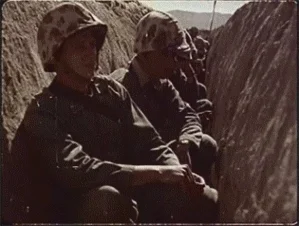
Now, NATO anticipated a more protracted war.
America ramped up defense spending and increased its troop presence in Western Europe.
Over the coming decades, America deployed nuclear weapons to Europe, and the alliance drafted military strategies that gave NATO more flexibility in the battlefield use of these weapons.
Keeping Germany Down
East Germany fell under Soviet influence, while West Germany fell under Western influence.
The city of Berlin, snug in the heart of East Germany, was split as well.
Berlin was at the center of several high-stakes Cold War crises.
NATO faced the question of what to do with West Germany In 1949.
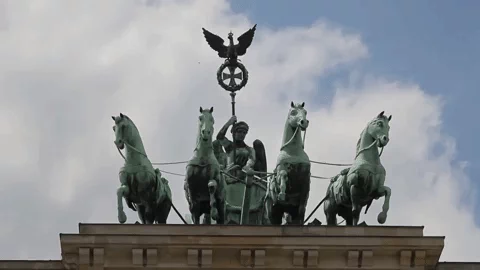
The German Question
A West German government was established in 1949: the Federal Republic of Germany. But it was also the year the Soviets acquired the A-bomb.
This didn't just portend a more significant American commitment to NATO. It also made it clear to the Alliance that it needed an economically and militarily strong West Germany.
If a protracted war broke out — which many anticipated would be fought on German soil — German membership in the Alliance would make it much easier for NATO to coordinate its defense.
 West Germany was given its independence, but puzzles remained:
West Germany was given its independence, but puzzles remained:
America and many in NATO wanted West Germany to be an independent, prosperous country.
At the same time, there was trepidation that West Germany could once again become assertive enough to make trouble on the continent. It could even decide to acquire nuclear weapons.
But if America and its European allies left West Germany too weak, it might seek peace with East Germany and the Soviet Union.
Eventually, agreements and conditions were hashed out.
West Germany forswore developing weapons of mass destruction on its territory.
West Germany's occupiers were given the right to intervene in its domestic affairs if there was a major threat to its democracy.
Allied powers reserved the right to station troops in Germany indefinitely. These forces, however, served less as an occupying force than a defensive one.
West Germany was allowed to rearm, though its military was integrated into a NATO command structure led by American generals.
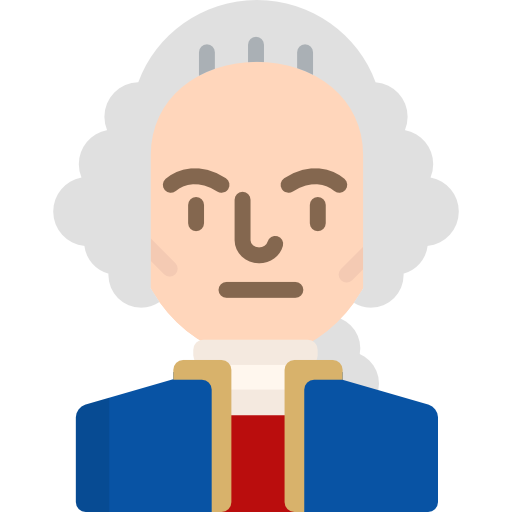 This last condition was critical. It was designed to keep West Germany's military from having too much independence.
This last condition was critical. It was designed to keep West Germany's military from having too much independence.
NATO would keep an eye on West Germany throughout the Cold War. But with these guardrails in place, West Germany was invited to join NATO in 1954 and joined the alliance a year later.
On the other side of the equation, the Soviet Union and its satellite countries formed the competing Warsaw Pact in 1955, which included East Germany.
End of History
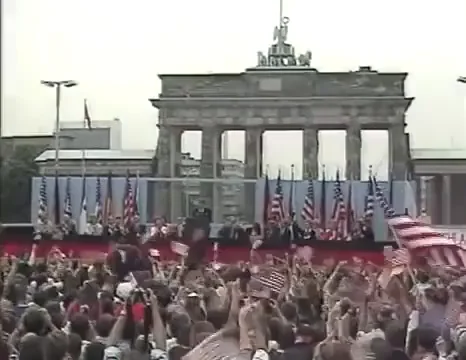
The Soviet Union collapsed in the early 1990s. To many observers, communism was an unproductive economic and political model. Liberalism, in contrast, appeared to be on the rise.
Though NATO and the strategy of containment evolved over the decades, the basics remained essentially unchanged: keep the Americans in, keep Germany down, and, perhaps most importantly, keep Russia out of Western Europe.
Historians question whether the Soviet Union ever seriously contemplated an invasion. Moscow may have only intended to use the threat of force to shatter the Alliance from the inside.
In any case, NATO held together through the Cold War. It also didn't disband in the 1990s when it no longer had a superpower adversary.
NATO had developed institutions, standard practices, and a sense of tradition. The Alliance had also invested in integrating its militaries and training their forces to conduct military operations.
So, it stuck together and found new missions: it sought to expand the Alliance and preempt threats to European and international peace and security.
Post-Cold War Mission One: NATO Expansion
NATO has expanded in waves throughout its history. It didn't grow much beyond its 12 founding members during the Cold War but became more welcoming following the USSR's dissolution.

Cold War
📍1949: Belgium, Canada, Denmark, France, Iceland, Italy, Luxembourg, Netherlands, Norway, Portugal, United Kingdom, and the United States
📍1952: Turkey and Greece
📍1955: West Germany
📍1982: Spain
📍1990: Germany
Post-Cold War
📍1999: Czech Republic, Hungary, and Poland
📍2004: Bulgaria, Estonia, Latvia, Lithuania, Romania, Slovakia, and Slovenia
📍2009: Albania and Croatia
📍2017: Montenegro
📍2020: North Macedonia
📍2023: Finland
More than an Inch
Post-Cold War NATO expansion begins with Germany following the fall of the Berlin Wall. As East and West Germany began reunification, many wondered what would become of Germany in NATO.
By this time, Cold War tensions between the United States and the Soviet Union had begun to thaw.
But the superpowers were, once again, at odds: the Americans wanted Germany in the Alliance, while the Soviets wanted to keep a reunified Germany out.
America got its way. But how it did, continues to be a topic of great controversy.
American diplomats purported to have made in-person assurances promise to the Soviets that if Germany joined NATO, the Alliance would not expand any further east.
Though an informal promise would not be legally binding, Moscow has taken the matter very seriously.
Regardless, NATO opened its door following the collapse of the Soviet Union to countries that were once inside the Iron Curtain.
 Open Door
Open Door
NATO is an alliance founded on liberal principles.
The Alliance looked the other way in the Cold War when it let in less than democratic Portugal, Greece, and Turkey. Spain had already joined NATO following the death of its fascist leader, Francisco Franco.
NATO prioritized strategic importance. After the Cold War, many have seen NATO and its expansion as a tool for solidifying democracy and free markets in Europe.
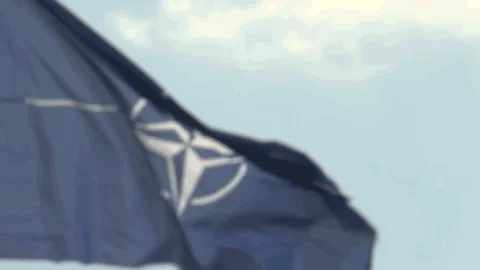
NATO extended a helping hand to former Eastern Bloc countries with membership aspirations in 1999 through its Membership Action Plan (MAP).
The MAP guides NATO hopefuls on the political, economic, and military reforms they must make to receive an invitation to join the Alliance.
Post-Cold War Mission Two: Out-of-Area Operations
In the 1990s and 2000s, NATO didn't just expand its borders. It also conducted operations beyond them.
This was a more proactive policy than containment. NATO now intended to stop perceived threats before they could reach its borders or harm its other interests.
This reflected what was seen as a shift in the world's geopolitical landscape.
 No longer was the world caught in an existential struggle between two superpowers.
No longer was the world caught in an existential struggle between two superpowers.
North American and European policymakers now lost sleep over terrorism, human rights violations, nuclear proliferation, and the prospects of failed states.
Notable examples of these operations include:
 Balkans (1994-1995, 1999)
Balkans (1994-1995, 1999)
NATO intervened twice in the conflicts which erupted in the Balkans upon Yugoslavia's collapse — a country whose ethnic tensions were held together by dictator Josip Tito.
Learn about this and the Alliance's shifting mission on None Of The Above. 👈
 Libya (2011)
Libya (2011)
NATO conducted airstrikes when it intervened to prevent Libya's ruler Muammar Gaddafi from following through on his threats to commit genocide to quell a rebellion against his rule.
 Afghanistan (2001-2021)
Afghanistan (2001-2021)
The 9/11 terrorist attacks triggered Article V of the North Atlantic Treaty. NATO allies provided aerial surveillance while America invaded Afghanistan.
NATO later conducted counterterrorism operations and advised and trained the Afghan military.
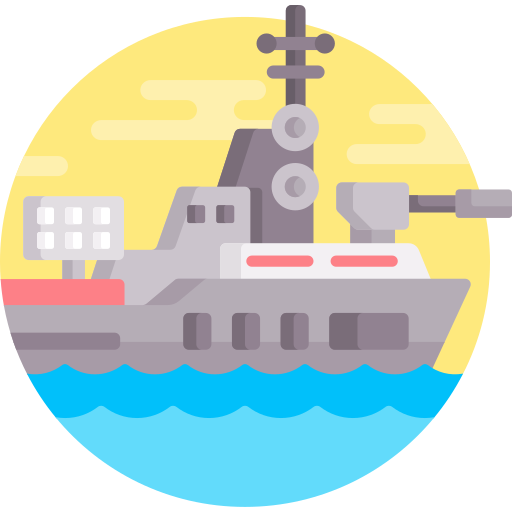 Anti-Piracy (2008 - 2016)
Anti-Piracy (2008 - 2016)
With piracy on the rise off the Horn of Africa, NATO responded to the UN's call to patrol the Indian Ocean. The most infamous piracy incident inspired the Tom Hanks film Captain Phillips.
Transatlantic Disunity

NATO aims to build consensus among its members when deciding what policy or action to pursue. But this can be easier said than done. States have their own interests and may have their own ways of doing things that are at odds with the rest of the Alliance.
During the Cold War, disputes among its members and crises challenged transatlantic unity.
France, for example, withdrew from NATO's integrated military command structure in the 1960s, only to return in 2009.
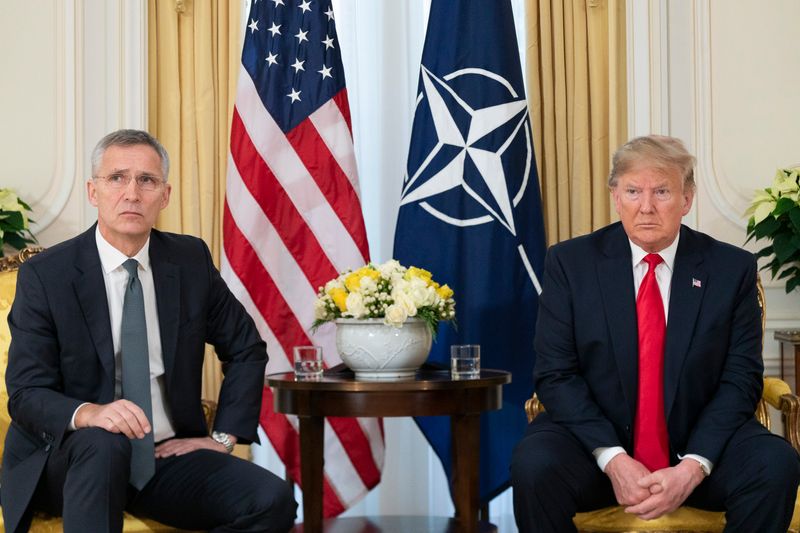 NATO Secretary General Jens Stoltenberg shares an awkward moment with President Donald Trump.
NATO Secretary General Jens Stoltenberg shares an awkward moment with President Donald Trump.
Post-Cold War Troubles
NATO's post-Cold War expansion and out-of-area operations appeared to give NATO a new purpose. Still, without the looming threat of the Soviet Union, tensions pervaded the Alliance.
NATO is often called "sacrosanct", or untouchable. But the Alliance's necessity in a post-Cold War world continues to be questioned.
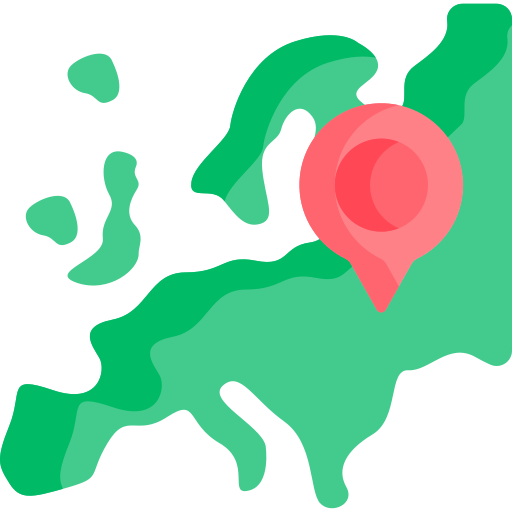 Should NATO Stay in Europe?
Should NATO Stay in Europe?
NATO's out-of-area operations have been seen as a distraction from its original purpose: to defend the territory of its members.
Counterterrorism and nation-building efforts require a much different force than that necessary for territorial defense. This, some argue, has left NATO unprepared to address more traditional security concerns.
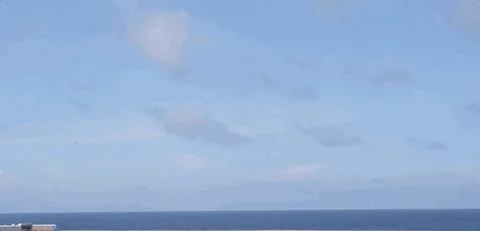
The success of NATO's operations has also been mixed:
Conditions in the Balkans did stabilize following NATO's intervention. But core issues were left largely unsolved — issues that continue today. NATO's bombing of Serbia in 1999 also contributed to deteriorating relations with Russia.
NATO's intervention in Libya stopped Gaddafi in his tracks. But at what cost? Gaddafi was killed with no regime to replace him, and the country's civil war soon spun out of control.
Afghanistan's reconstruction stretched on for years. And when NATO withdrew from the country, the Afghan military quickly collapsed. America's decision to withdraw its troops from Afghanistan also created a rift within the Alliance, as some members argued that Washington never properly consulted them.
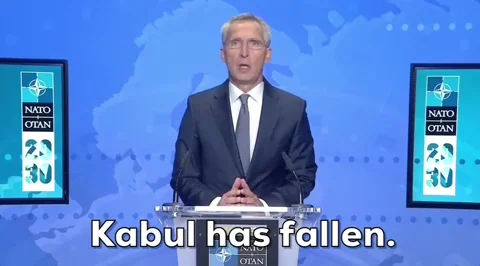
It has also been questioned whether counterterrorism in the Middle East and Africa is as vital for the United States as it is to a country like France, which is much closer to these regions.
 Should the US Go It Alone?
Should the US Go It Alone?
The United States and Europe sometimes don't see eye to eye. An infamous example was America's invasion of Iraq in 2003.
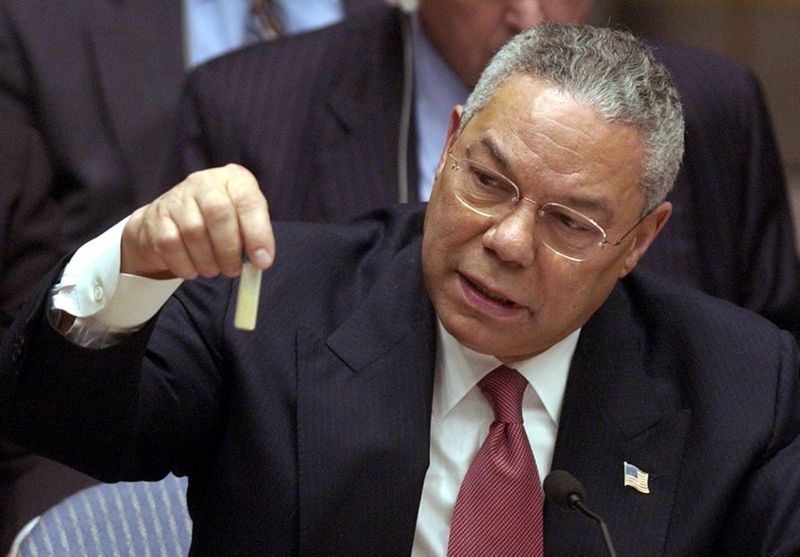
If you ever wanted to know why the United States started calling French fries "Freedom fries," here's the story:
While the United States got Poland and the United Kingdom to participate in its invasion of Iraq, Washington failed to sell France (and Germany) on its dubious evidence that Iraq had weapons of mass destruction.
NATO was divided on the merits and legitimacy of America's invasion and didn't participate.
And as tensions between the US and China grow, it is questionable whether the United States can devote its attention to both Europe and Asia...or if European countries even view China as a threat in the same way as the United States does.
 Is Europe free-riding?
Is Europe free-riding?
Free-riders (or "cheap riders") benefit from services or goods but don't pay their fair share.
NATO members pledged to spend 2% of their gross domestic product on defense. Today, not all members meet this pledge, including Germany, which has the most robust economy in Europe. Nor has Canada, which acknowledged that it will never meet this goal.
Many argue this places an undue burden on the United States, which shoulders much of NATO's cost.

US Presidents from both political parties have called for member states to take more responsibility, but President Trump went farthest by suggesting the US could withdraw from the Alliance entirely.
The Trump administration is regarded as a low point in alliance unity.
Is NATO expansion worth it?
As NATO opened its door to Eastern European countries in the 1990s, and as these countries worked to join the Alliance, there was much debate on the wisdom of expansion.
This is an argument that continues to this day.
 Supporters
Supporters
It supports European integration, which makes the continent more prosperous and secure.
It supports and promotes democracy in Europe.
NATO is made stronger with more members and deters Russian aggression against members of the Alliance.
 Critics
Critics
Europe is now wealthy and can take responsibility for its defense.
Having too many countries makes the Alliance unmanageable and individual countries harder to defend.
It's unnecessarily provocative to Russia and ignores Moscow's legitimate security concerns.
Post-Post Cold War
Russia's unjust invasion of Ukraine has appeared to focus NATO's attention back on Eastern Europe.
As the Russia-Ukraine war unfolds, the discussions of commentators and experts turn to the past to understand the causes of the conflict and the present for answers on how NATO can defend itself and support Ukraine.
Past is Prologue
Ukraine is a former Soviet Republic with a long, complicated history with Russia.
Russian President Vladimir Putin has sought to bring Ukraine back under Russian influence. He has provided his reasons for invading Ukraine — many of which are based on fictitious accounts of history and current events.
But there is much debate today on the role NATO expansion played in the Russia-Ukraine conflict.
Ukraine Membership — An Open Question
NATO's open-door policy was extended to Ukraine and Georgia (another country Russia has invaded) in 2008. Yet membership proved elusive. Ukraine, like many former Soviet republics, struggled to democratize and weed out corruption.
Progress was made. But in 2014, perhaps anticipating NATO's further encroachment on its borders, Russia illegally annexed the Ukrainian territory of Crimea.
Russia also provoked and participated in separatist fighting in Eastern Ukraine, which further derailed Ukraine's membership.
Had Ukraine joined NATO earlier, would an invasion have occurred?
NATO Refocused
At least for the moment, the Russia-Ukraine war appears to have unified NATO rather than divide the Alliance.
NATO has bolstered its defenses on its eastern flank, which is most vulnerable to Russia.
NATO members have levied economic sanctions on Russia and continue to support Ukraine with financial and military aid.
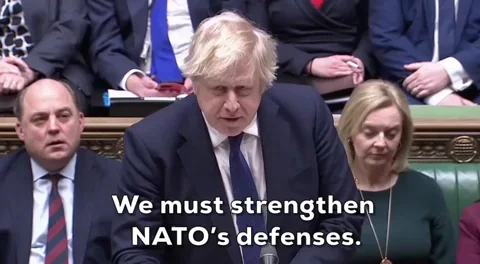
Finland and Sweden, which have traditionally valued their neutrality, began talks to join the Alliance soon after Russia's invasion. Finland officially joined NATO on April 4, 2023.
At the start of the war, Germany — which had been the most reluctant to pursue a robust national security strategy — announced it would take more responsibility for its defense.
Take Action
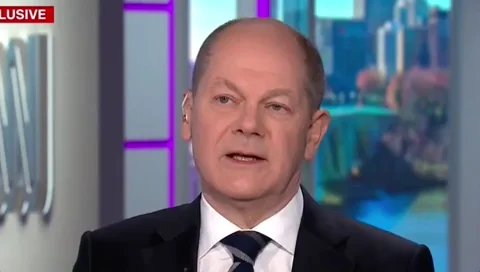
Discussions on the Russia-Ukraine war look to the future as well. NATO appears revitalized on the surface, but significant cracks remain.
And these cracks could grow...
 Critics argue that the United States is doing too much of the heavy lifting of supporting Ukraine's defense. Europe, they contend, needs to do more to handle a conflict in its backyard.
Critics argue that the United States is doing too much of the heavy lifting of supporting Ukraine's defense. Europe, they contend, needs to do more to handle a conflict in its backyard.
 Germany, for example, has been slow to make good on its promise of a more robust defense policy.
Germany, for example, has been slow to make good on its promise of a more robust defense policy.
 In the long term, it's still unclear if Europe can continue to wean itself off Russian oil and natural gas.
In the long term, it's still unclear if Europe can continue to wean itself off Russian oil and natural gas.
 And then there is the question of what NATO is to do about Hungary, Poland, Turkey, and other countries where democracy has eroded.
And then there is the question of what NATO is to do about Hungary, Poland, Turkey, and other countries where democracy has eroded.
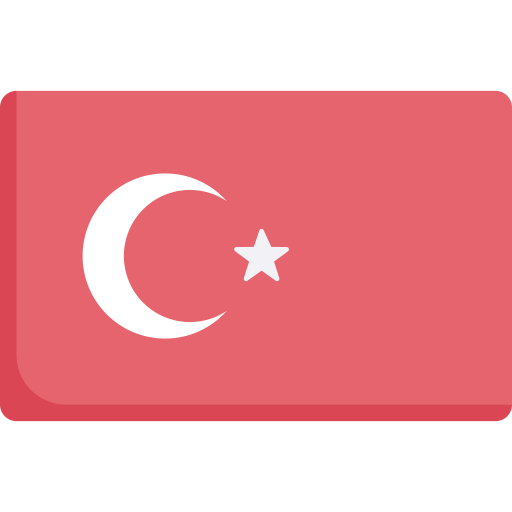 Meanwhile, Turkey and Hungary have so far blocked Sweden from joining NATO. Turkey is also frequently at odds with the other allies on issues related to the Middle East.
Meanwhile, Turkey and Hungary have so far blocked Sweden from joining NATO. Turkey is also frequently at odds with the other allies on issues related to the Middle East.
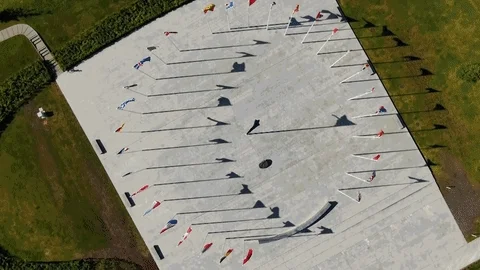
There are many more open questions about NATO's future. To help you consider these questions, you can listen to these episodes of EGF's podcast, None Of The Above:
American Supremacy: Stephen Wertheim on the Decision for Military Dominance
Illiberal Allies: James Goldgeier and Elmira Bayrasli on the Challenge of a Democracy Summit
Moscow Meddling: Terrell Jermaine Starr on Rightsizing the Russia Challenge
How to End the Ukraine Crisis: Thomas Graham and Rajan Menon on Negotiating with Russia
Big Daddy Moscow: Nataliya Gumenyuk and Peter Pomerantsev Get Inside Putin's Mind
Russia's Red Lines: Where the Russia-Ukraine War Stands at One Year
Defending Europe: How the Transatlantic Alliance Protects and Imperils American Security
How the War in Ukraine Ends: A Conversation with General Mark Milley
As you peruse these resources, here are a few questions for you to think about:
This Byte has been authored by
Lucas Robinson
Foreign Affairs Professional
